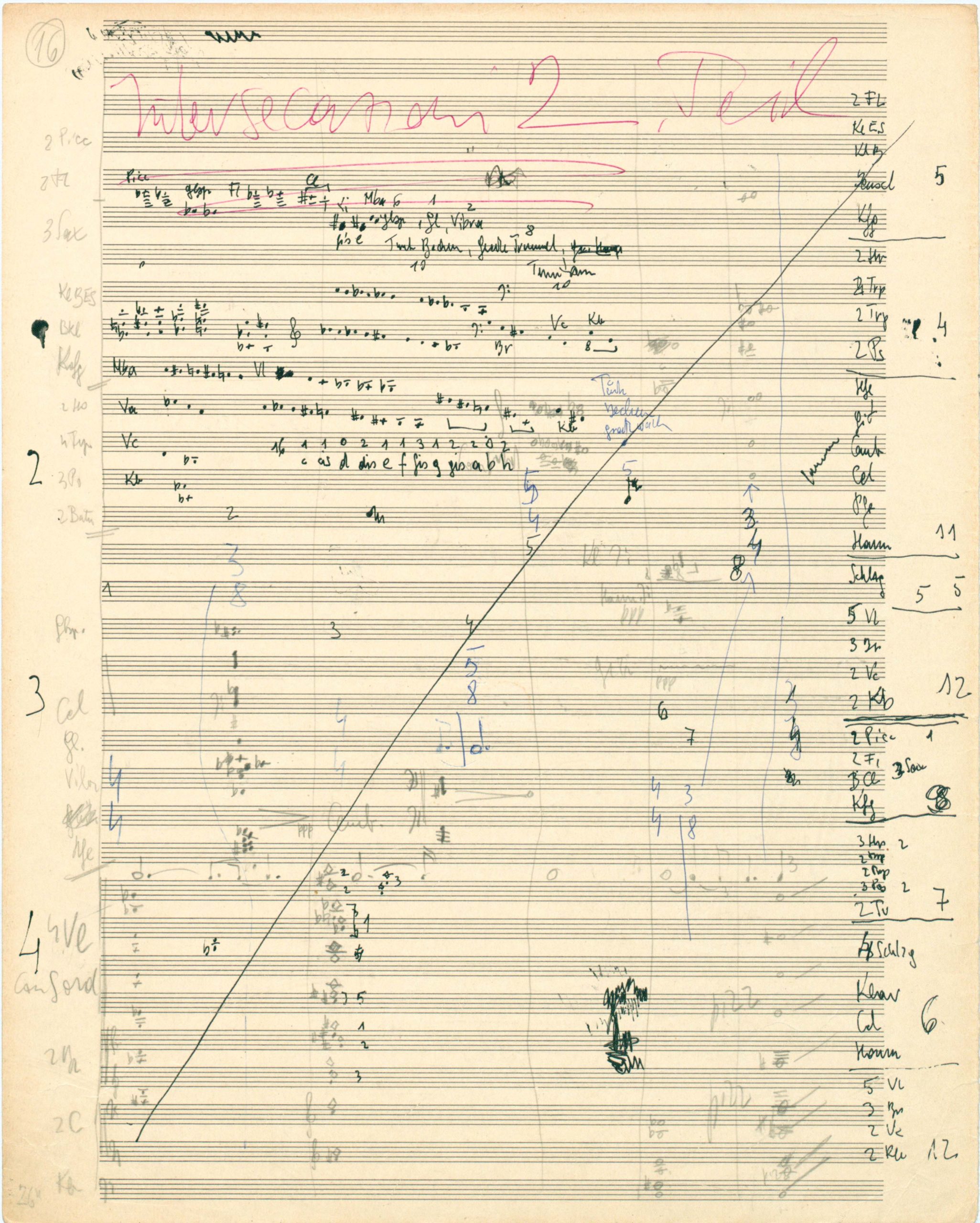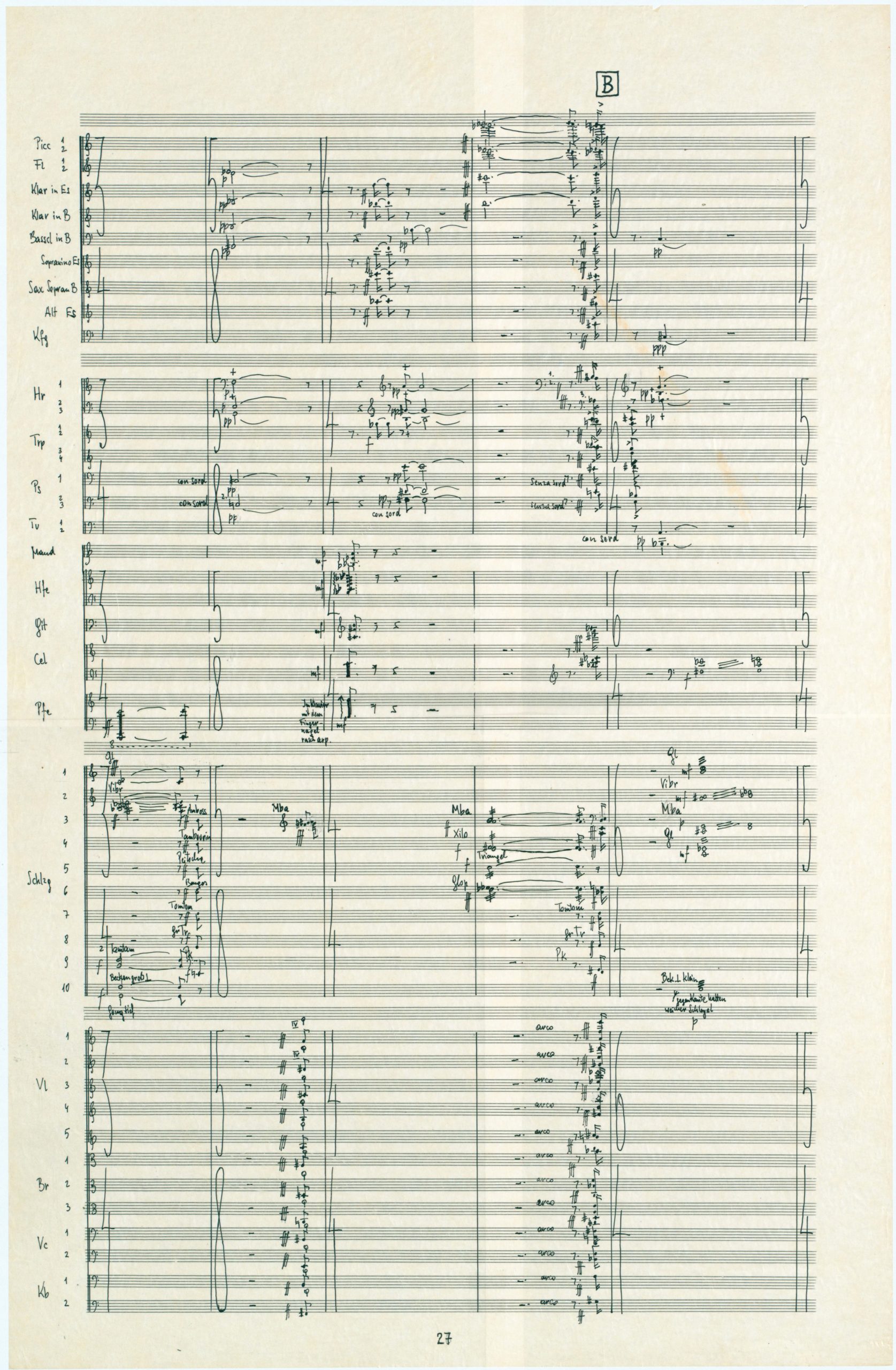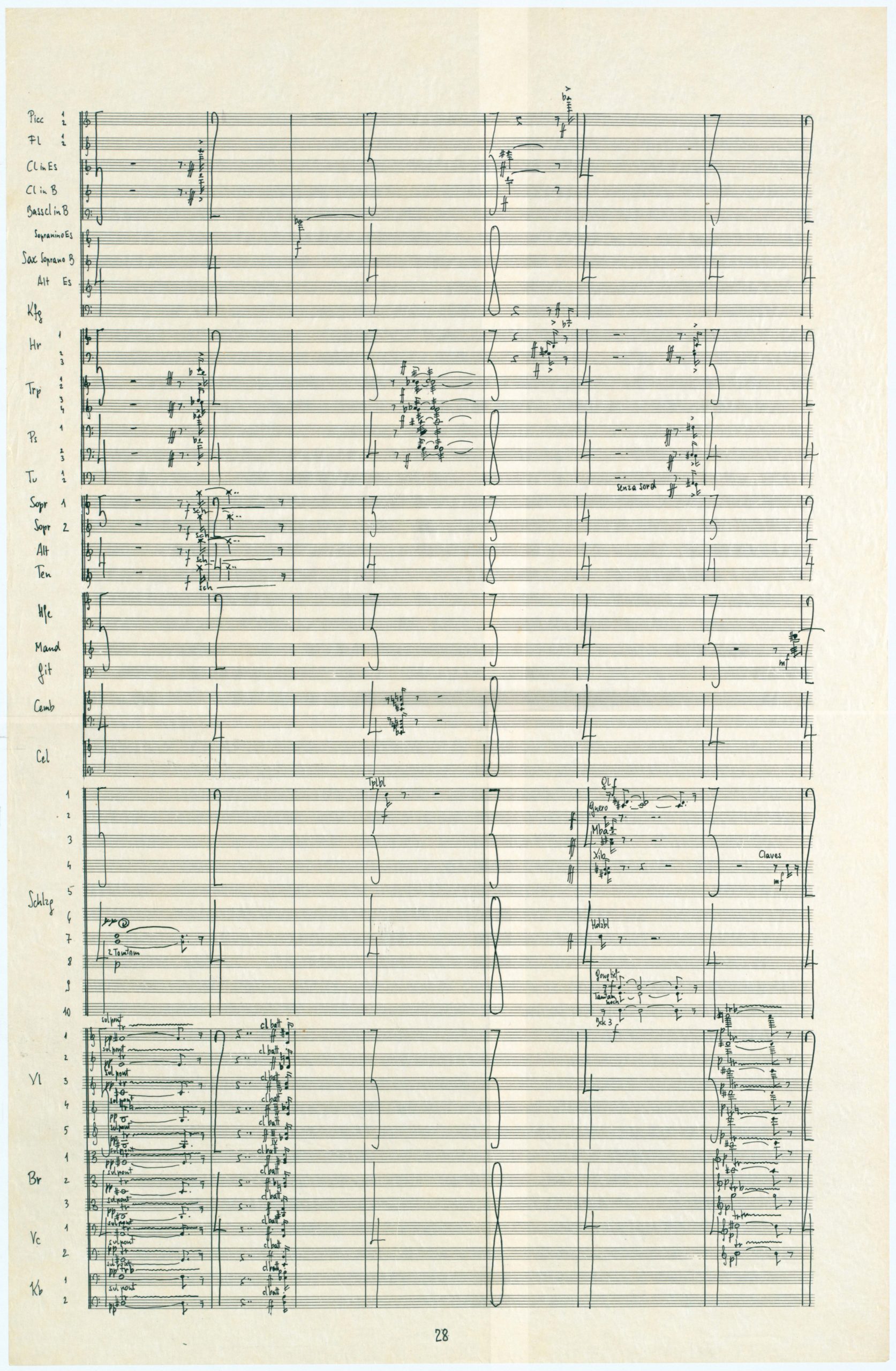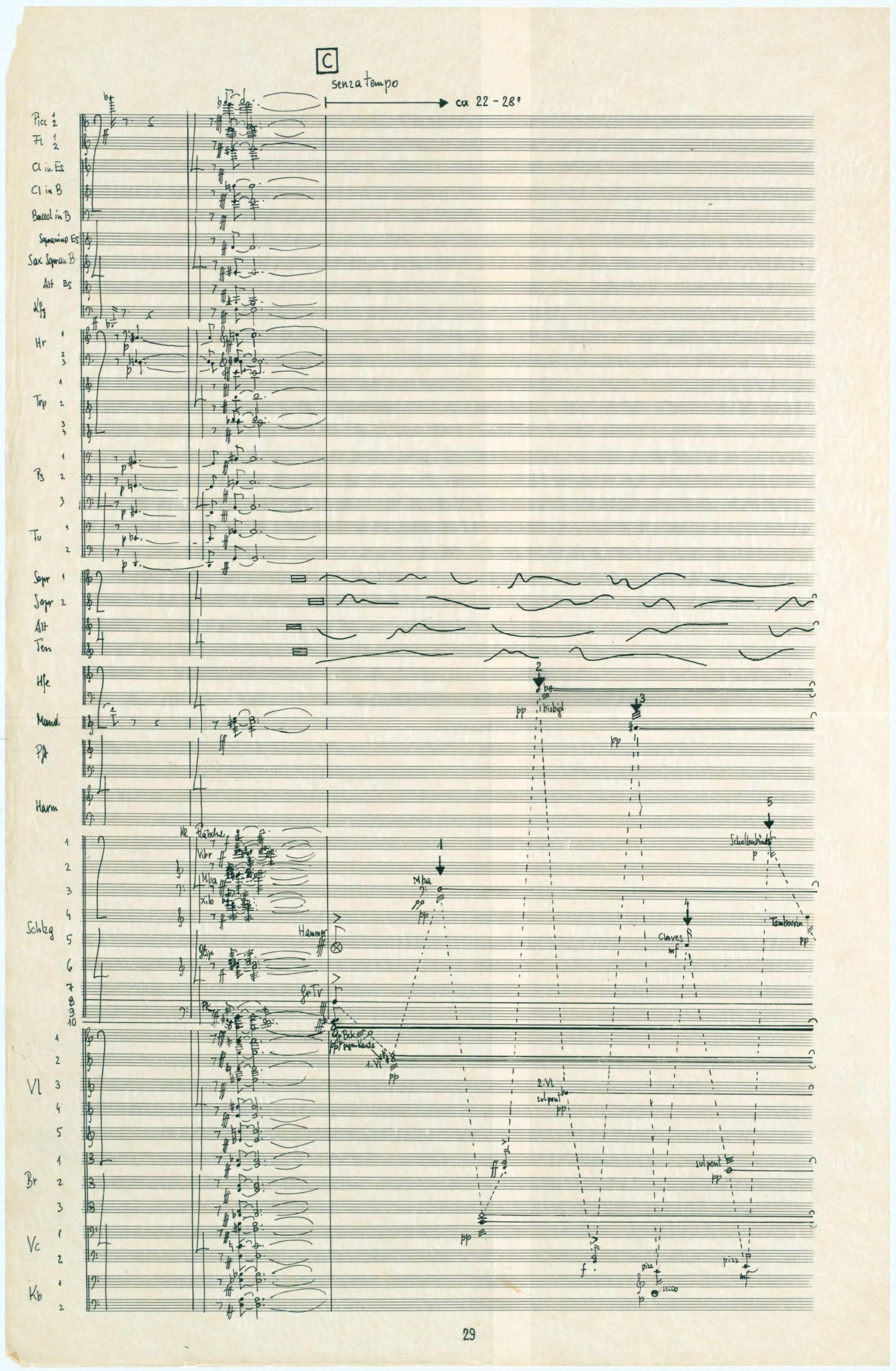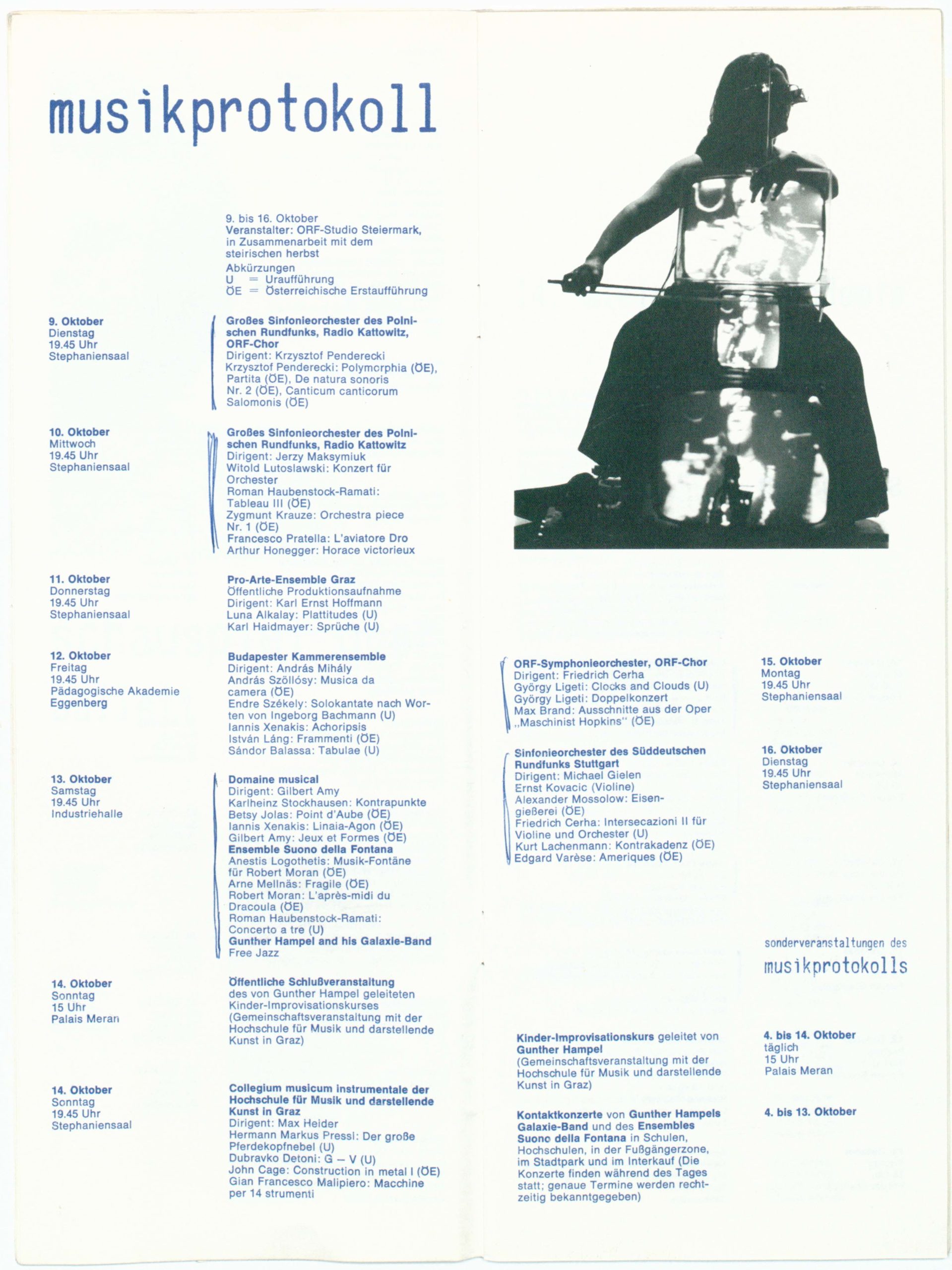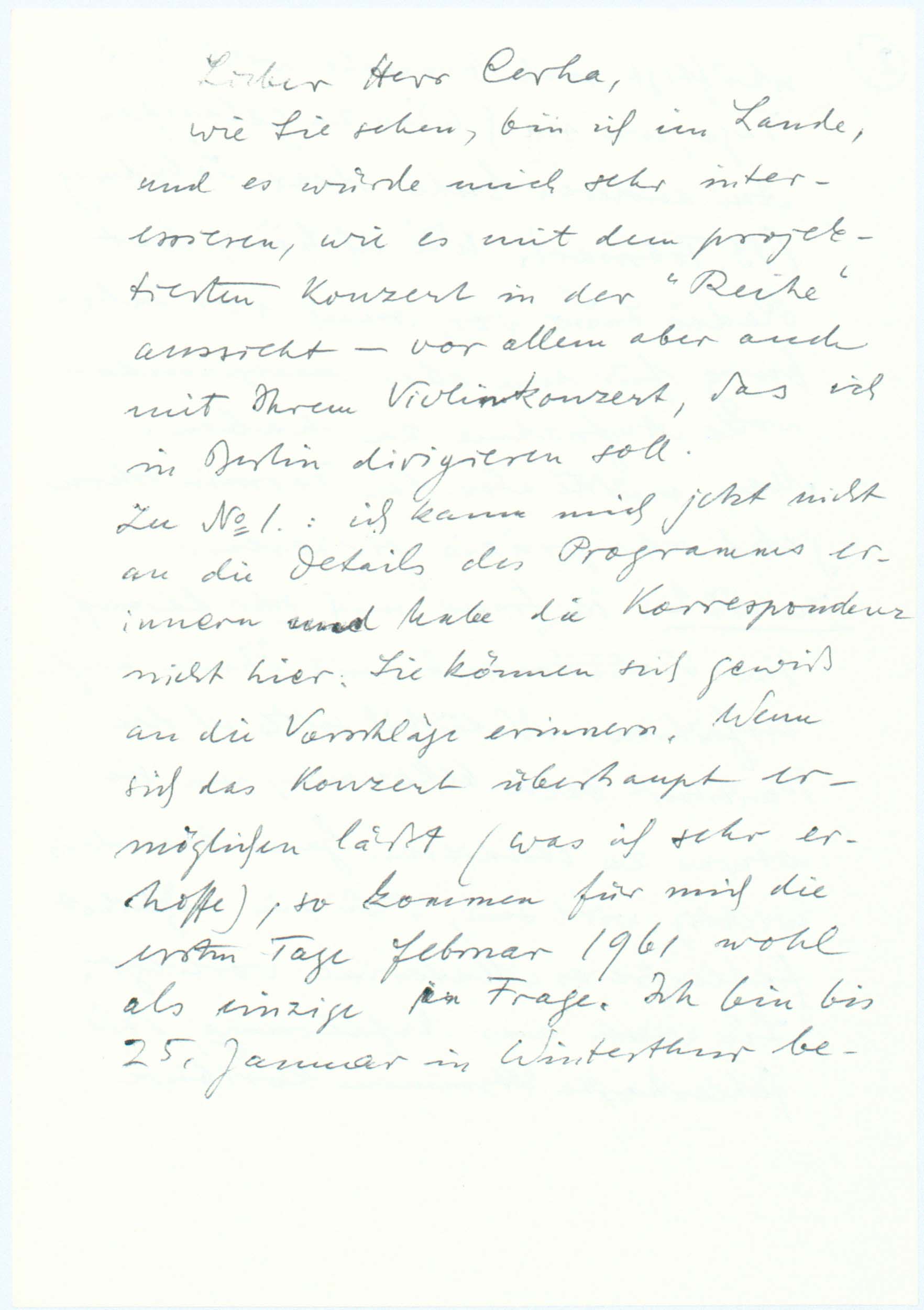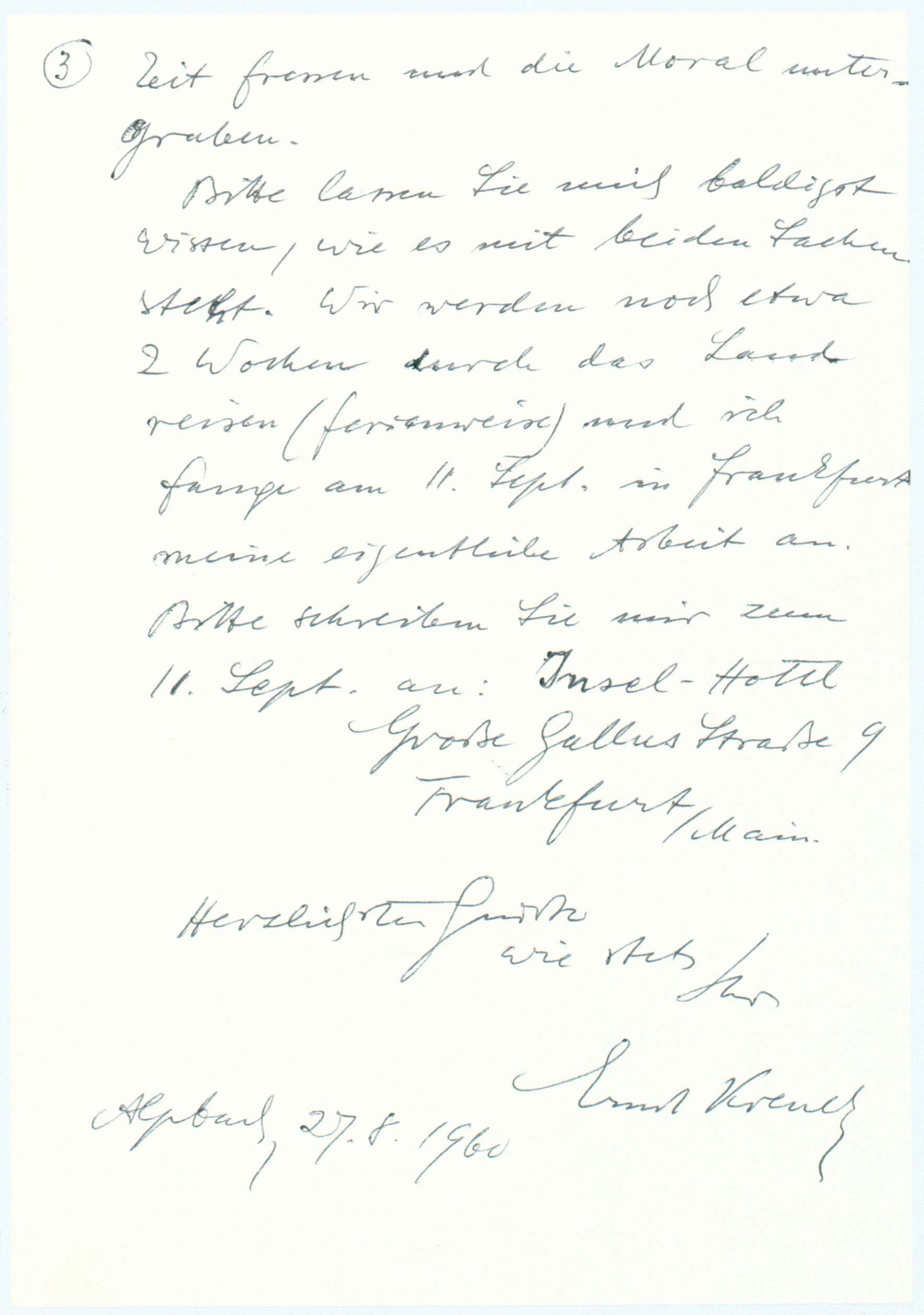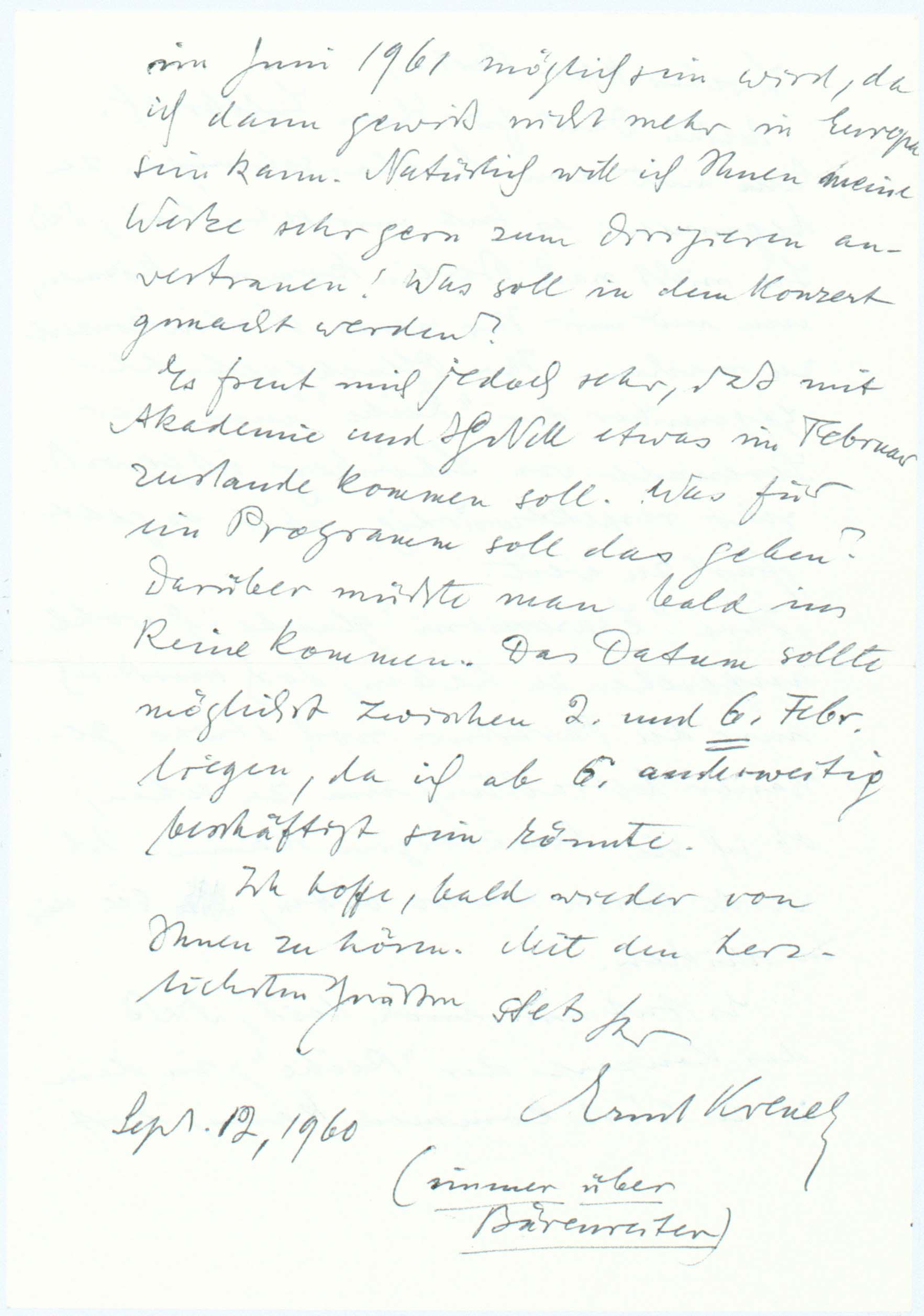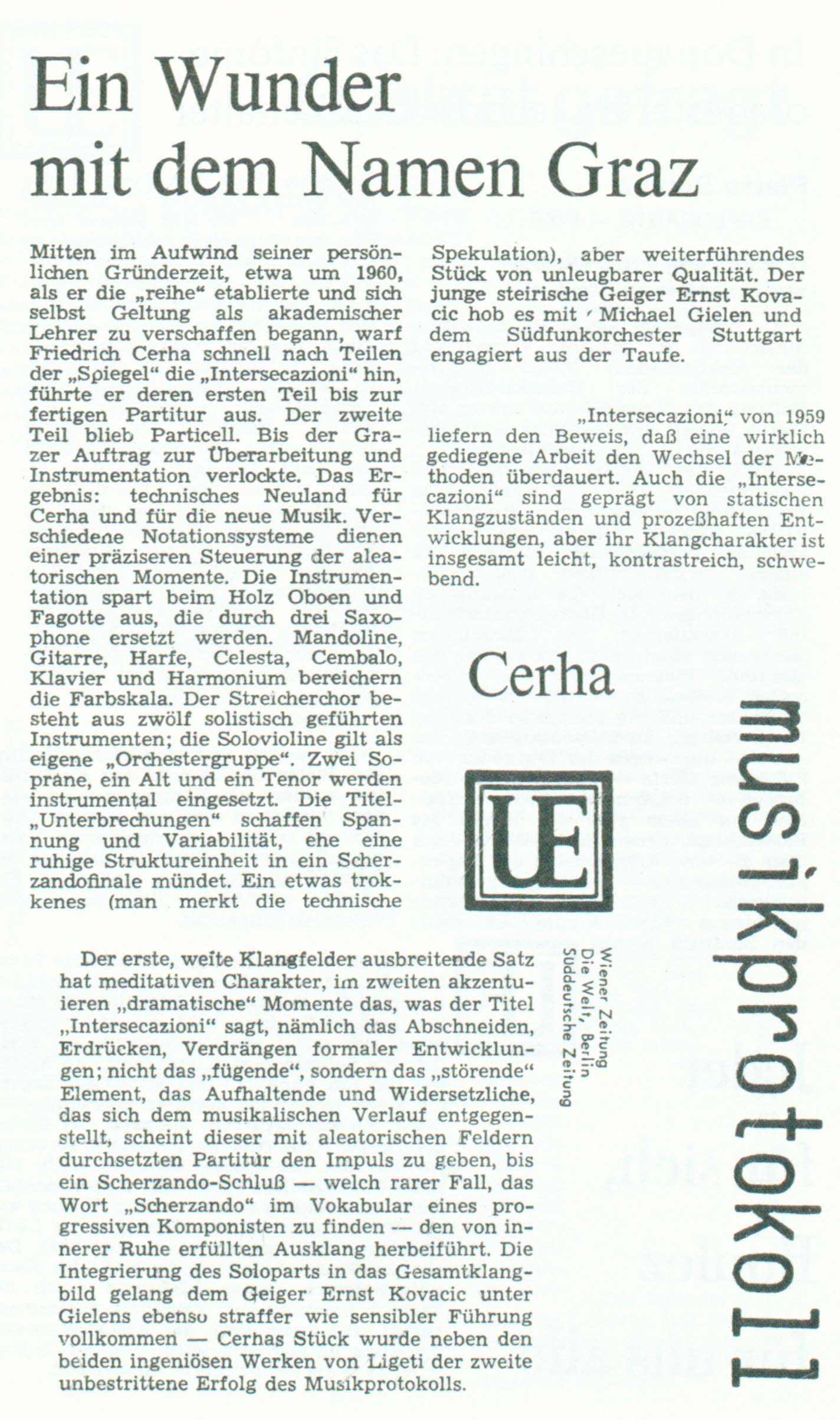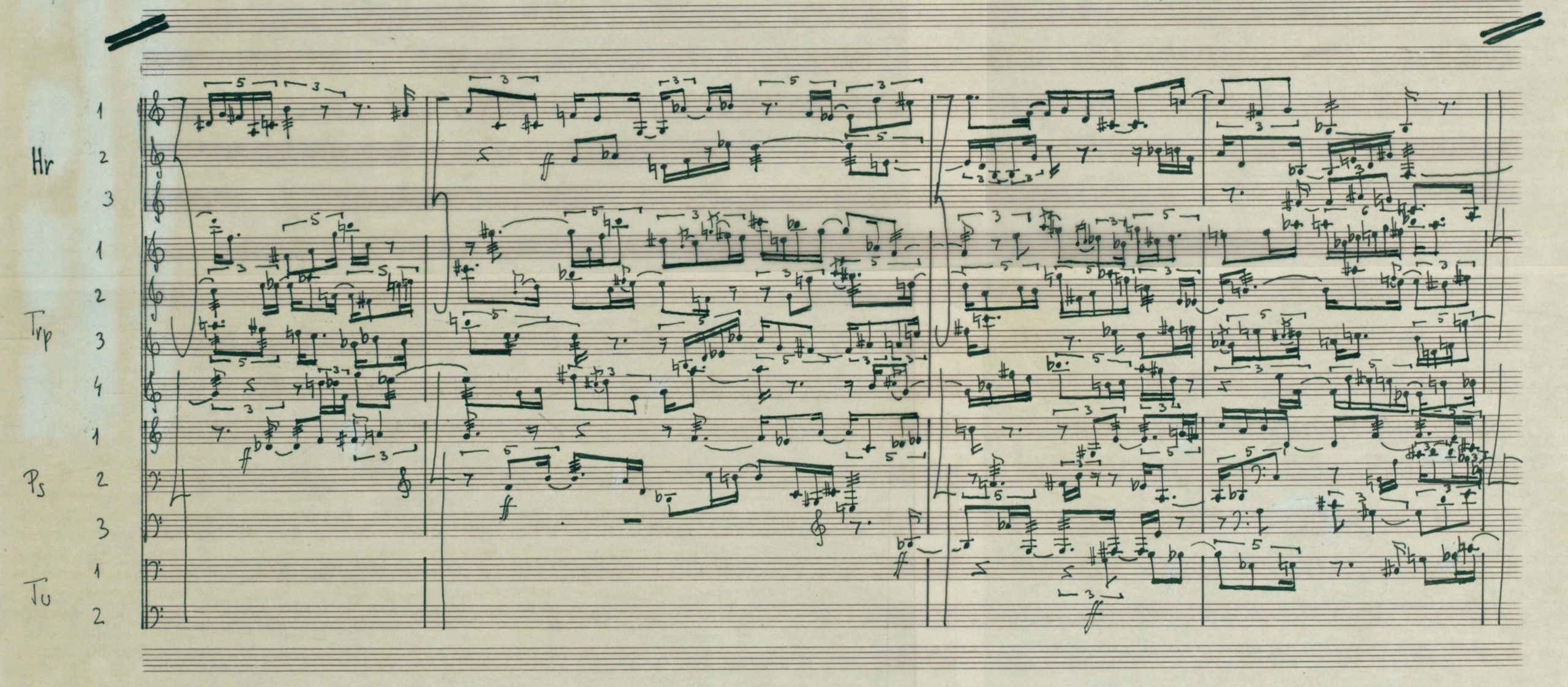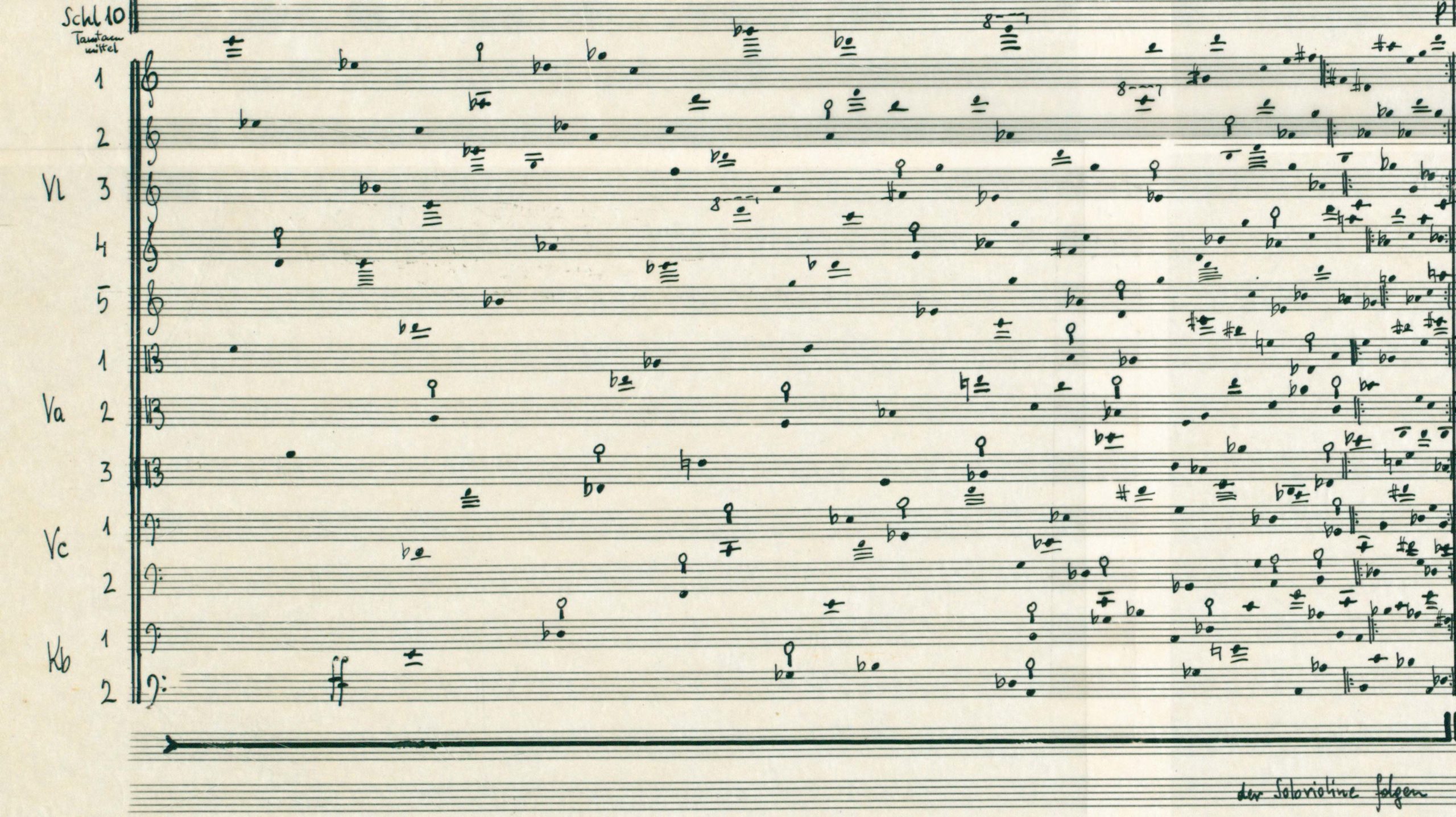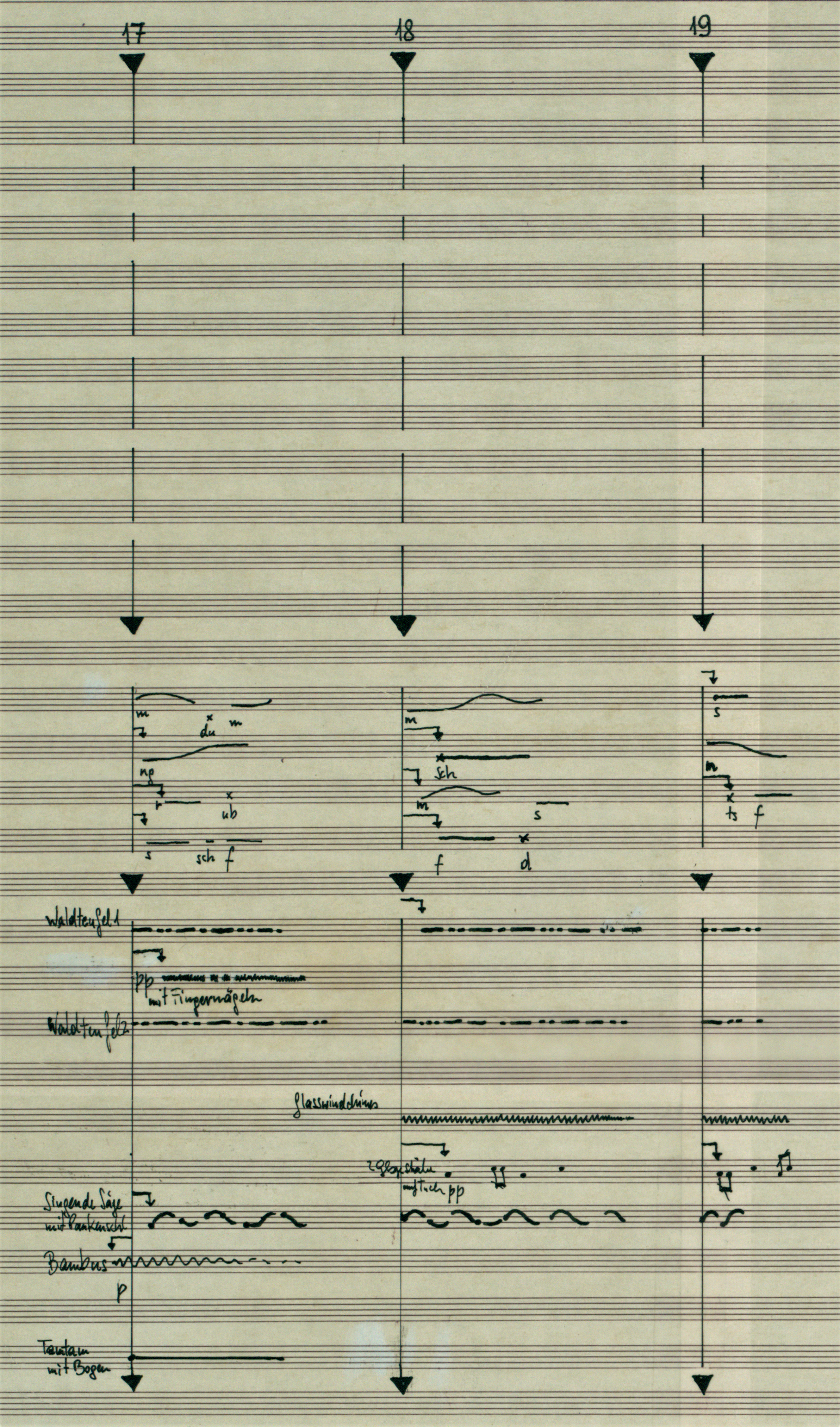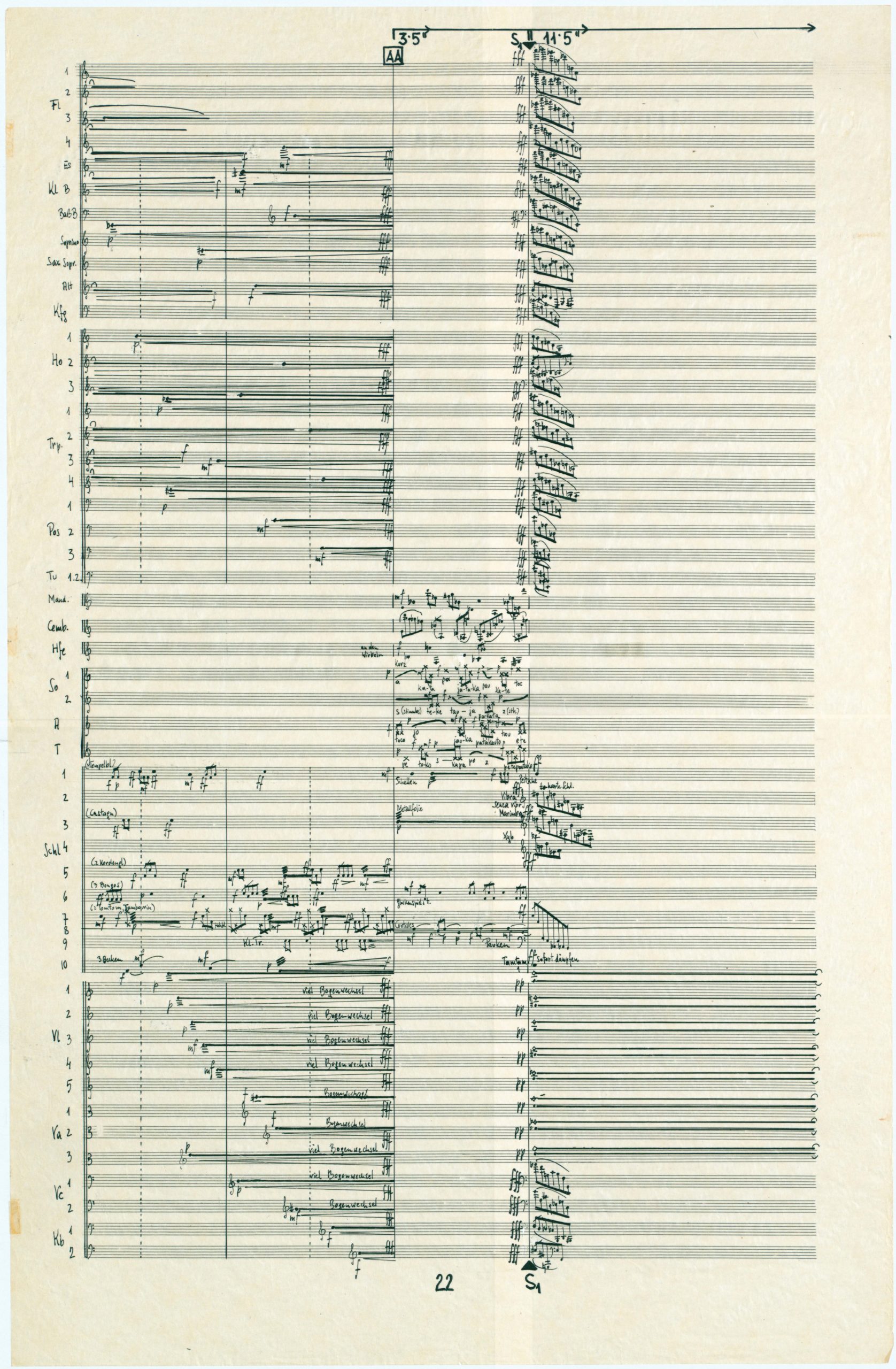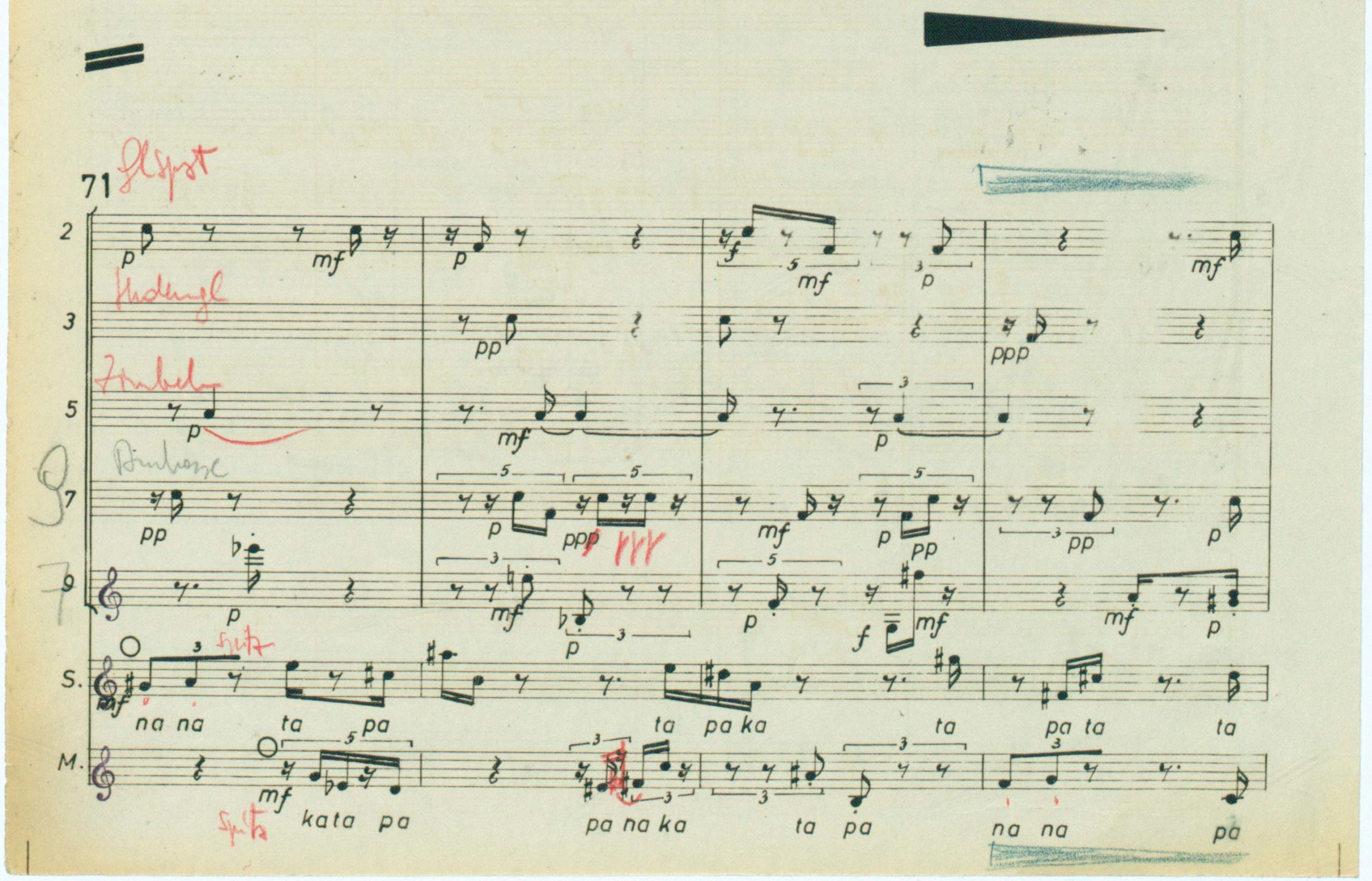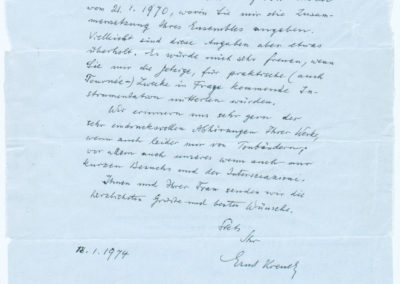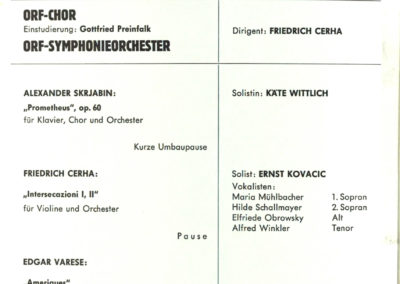Intersecazioni
Die Schönheit der Störung
Fasce
Netzwerk
Friedrich Cerha, Ohne Titel
Mixed media on wood, 64 x 103 cm
In the 1960s, Cerha was highly interested in contrasting and disrupting different materials—both musically and visually. A painting from this period is particularly effective at demonstrating his horizontal and vertical play with textures—a creative process that is also significant in his orchestral work Intersecazioni.
Photo: Christoph Fuchs
A poster for the 1973 “Musikprotokoll” event in Graz suggests that music is a way of documenting vital signs.
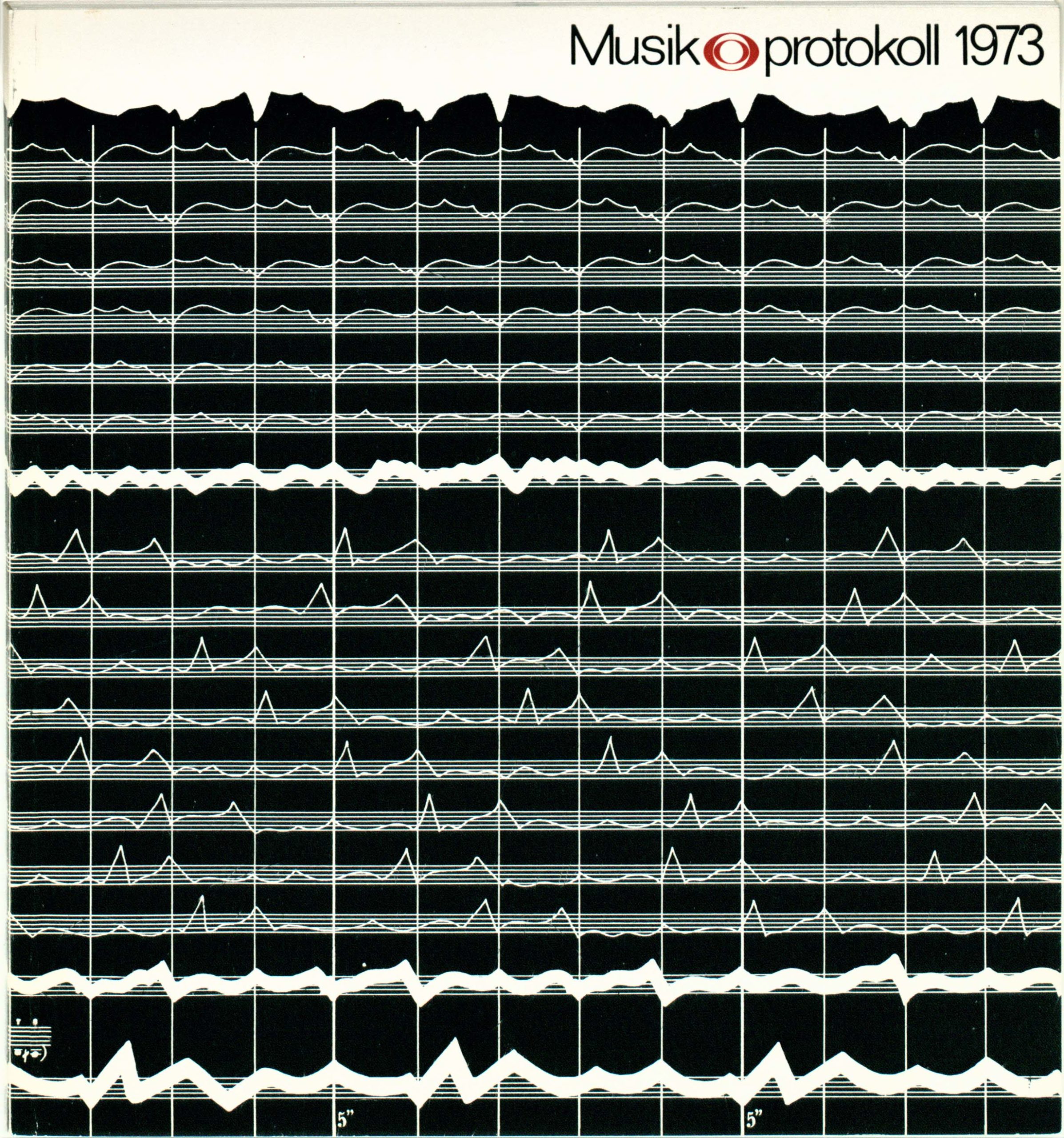
Cover of the “Musikprotokoll 1973” programme booklet in Graz, AdZ, KRIT0018/28
Nervous lines and jerking spikes contrast with the calm background of the musical staff and are reminiscent of a cardiogram recording. Certainly not solely by chance, the Musikprotokoll festival chose this design as the flagship for what was then still a young festival. The design makes a general statement: Founded in 1968, these concert events made possible something that was previously unthinkable in Austria—bringing experimental music to the big stage. Friedrich Cerha was among those who benefitted from this. In 1971 the first complete performance of the full orchestral cycle Spiegel was brought to the stage, quite the feat. 1975, Fasce is heard for the first time. Both works were written more than a decade earlier. The story of the orchestral piece Intersecazioni is similar. Composed in 1959, the work did not premier until 14 years later at the Musikprotokoll festival.
Außenansicht
The story of the long path leading up to the premiere of Intersecazioni is testament to Cerha’s strength of character. On the threshold of the 1960s, he composed a number of works that featured a large and/or “strange” instrumentation, augmented by unusual technical difficulties. These pieces were shaped by new methods of notation, with resulting demands on conductors and performers alike. The works, new at the time, were performed in the “hot spots” of the avant-garde scene (Cologne, for example, or Darmstadt). Performing a piece like Intersecazioni in Austria, however, remained nothing more than a dream for a long time. For many composers, that knowledge would likely have prevented them from putting their musical ideas to paper. But not Cerha: He composed out of sheer conviction, and at that time perhaps more freely than ever before. Even so, the unique situation did leave its mark:
Intersecazioni for violin and orchestra was composed in 1959. In view of the wealth of concepts that occupied me at the time, and my lively activities as a conductor and university professor, as well as the total impossibility of seeing a piece of this kind performed in this country, the second part of the piece was left as a short score, only to be fully instrumented in 1972/73.
Friedrich Cerha
Schriften: ein Netzwerk, Vienna 2001, p. 224
The sketches corresponding to Intersecazioni reveal that Cerha had very specific instrumental colours in mind for the musical realisation from a very early stage. He refined these ideas on the occasion of the work’s subsequent premiere at the Musikprotokoll festival. The beginning of the second of the two movements illustrates a ground-breaking way of thinking in blocks of alternating colour.
Cerha, Intersecazioni, Skizzen, AdZ, 000S0054
Cerha, Intersecazioni, Autograf, AdZ, 00000054
Friedrich Cerha, Intersecazioni, 2. Satz, Beginn
Stuttgart Radio Orchestra, Ernst Kovacic, Michael Gielen, world premiere at Musikprotokoll Graz on 16 October 1973
Looking at the first few pages of the finished score for the Graz premiere, it at first seems surprising that the piece was difficult to perform. Any professional conductor wouldn’t have had much difficulty guiding the orchestra in producing the blocks of chords framed in changing time signatures. On the last of the pages shown here, however, one begins to see that this scheme is only passing through: An entirely different passage is now noted; full bars are missing completely. The entire piece is characterized by the concept of change.
Brücke
The theme of Musikprotokoll 1973, where Intersecazioni was premiered, was “Futurism”. At the time, there were performances of many pieces from the 1920s that had been written on the subject of machine music: Alexander Mosolov’s Iron Foundry and Max Brand’s opera Maschinist Hopkins were performed alongside Amériques by Edgard Varèse, a composer whom Cerha particularly admires and often performed. The festival motto was also fitting for the premiere of Intersecazioni, even without the work emulating a machine aesthetic per se. It was more about the futuristic attitude of writing uncompromising music. “In terms of language and form”, Cerha explains, it is the “most complex piece” from his serial compositions period. It is “perhaps the boldest—certainly” but “the least smooth.”Schriften: ein Netzwerk, Vienna 2001, p. 224 At the summer colloquium of the Archives of Contemporary Arts in 2015, Cerha described the work’s willingness to take risks in more detail.
Cerha über Intersecazioni
Mitschnitt, Sommerkolloquium des Archiv der Zeitgenossen, Krems 2015
The idiosyncratic use of the orchestra in Intersecazioni is quite innovative, rendering traditional labels of little use. At first glance, one might even assume that the piece “for violin and orchestra” is a modern violin concerto. If so, it would then be Cerha’s first of the kind, because although a violinist himself, Cerha did not compose a concerto for the instrument until 1959. His oeuvre did, however, already include a particularly large number of pieces for violin and piano, a combination that Cerha used to test new techniques before later transferring them to a larger musical body. In 1960, Cerha wrote several letters to his fellow composer and conductor Ernst Krenek, who, like Cerha, was exploring the terrain of serialism despite his comparatively advanced age, and acting as a mediator between the older and younger generations at the Darmstadt Summer Courses for New Music. It is clear from this correspondence that Intersecazioni was to be premiered in Berlin under Krenek’s direction. However, the plan could not be implemented, as Cerha was not able to take part in the rehearsals. Instead, he sent Krenek the score to Espressioni fondamentali, which was written using a much more practical notation method and therefore manageable.
Ernst Krenek, letter to Cerha, 28.8.1960,
AdZ, BRIEF004/81 ff.
Ernst Krenek, letter to Cerha, 12.9.1960,
AdZ, BRIEF004/79 ff.
What is interesting about the exchange of letters is that both composers speak of Intersecazioni as being a “violin concerto”. However, there is no question of such a concerto. Although Cerha does use a solo violin, it is on equal footing with other instrumental groupings:
The solo instrument is used neither as a counterpart to the orchestra, as in old and some new solo concertos, nor—as is often the case with Ligeti—as a part, albeit a somewhat more important one, of the overall soundscape. The violin takes on the function of an orchestral group, but one consisting of just one instrument.
Friedrich Cerha
Schriften – ein Netzwerk, Vienna 2001, p. 225.
Innenansicht
Viewing the orchestra as a subdivided body of sound, as a system with several subsystems, corresponds to a way of thinking that Cerha gradually found his way to during the composition phase. He was increasingly interested in how musical processes and states can interact to find new forms of composition. The Italian title, Intersecazioni, is an allusion to its conception, as Cerha explains:
The title Intersecazioni means interruptions. Developments are truncated, disrupted, crushed, suppressed, diverted to other paths. However, the term also applies to processes on the micro level, where these events cannot be registered in detail, yet are responsible for the internal organisation.
Friedrich Cerha
Schriften: ein Netzwerk, Vienna 2001, p. 225
The vocabulary that Cerha uses to describe these musical events can also be found in other commentaries on his work. About Fasce, composed the same year, Cerha explains that he sees the piece as a “system with different elements” that “influence, impede, disrupt, and turn off each another”.Schriften: ein Netzwerk, Vienna 2001, p. 227 In the composition Und du… (1963) he describes “sound processes that develop, influence, hinder, disturb, and the juxtaposition and interweaving of which is effective as a whole.“Schriften: ein Netzwerk, Vienna 2001, p. 230 Inseparable in all these characterizations, Cerha shows his closeness to Norbert Wiener’s cybernetics, referring to it explicitly for the first time with Fasce. According to Cerha, the approach of viewing music as a subdivided system led to a completely new “wealth of means and content” that enabled heightened complexity.Schriften: ein Netzwerk, Vienna 2001, p. 227. Despite the affinity arising from this concept, the chosen “means and content” differ in their details. In Fasce, Cerha emphasizes the connecting properties of the system—the music melds together as if from a single mould, with almost no fractures. The formal concept of Intersecazioni emerges as entirely different: Here, it is “not the ‘joining’ but the ‘disrupting’ element, the impeding and rebellious in opposition to the musical process” from which the music draws its compelling power, theatre critic Karl Heinz Ruppel wrote following the world premiere in the Süddeutsche Zeitung.Karl Heinz Ruppel, „Führend im Grazer Musikprotokoll: Ligeti und Cerha“, in: Süddeutsche Zeitung vom 30.10.1973, AdZ, KRIT0018_1973-1974/34
“Ein Wunder mit dem Namen Graz”, a compilation of reviews of Intersecazioni, AdZ, KRIT0018/62
Cerha’s musical gravitation towards these disruptive processes reveals his cybernetic thinking. Cultural scientist Claus Pias emphasizes the importance of the concept of disturbance for sciences still young in the 1950s:
When speaking of disturbance, it is almost impossible to avoid the topic of cybernetics. After all, in cybernetics disturbance is a crucial variable, therefore logically termed the “disturbance variable”. It is the agent of a control mechanism in which—beyond all possible difficulties of implementation—it is about achieving an adequate relationship between disturbance variables and control variables on an abstract level.
Claus Pias
„Störung als Normalfall“, in: Störfälle. Zeitschrift für Kulturwissenschaften 2/2011, pp. 27-44, here p. 27
In Cerha’s Intersecazioni, sound processes regularly disrupt, as part of the system, turning the disturbance into the “normal situation”—as is also seen in Pias’s cybernetic models. One consequence of this way of thinking is that the music shows itself in many, sometimes fundamentally different, forms. It can rightfully be said that none of Cerha’s previous works pursues such a multi-perspective structural system. A virtual leafing through the pages of the score quickly reveals this diversity. In the video below, several excerpts of episodes from the first movement are juxtaposed for comparison.
RSO Wien, Ernst Kovacic, Friedrich Cerha, Vienna, Great Hall of the Musikverein, 1976
ORF Edition Zeitton: Cerha-Dokumente, Vienna 2001
If one delves even deeper into Cerha’s artistic development, the word “adventurous” (a quality the composer himself attributes to the piece) is almost inadequate to describe Intersecazioni. The contrasts are huge: Rough and soft, sharp and velvety, impulsive and sunken, static and trembling—all qualities are found under the umbrella of a single piece. Apart from the musical characters, the work also emerges as a melting pot for Cerha’s musical inventions of the 1960s, a time of “feverish creation.”Schriften: ein Netzwerk, Vienna 2001, p. 225. The different degrees of freedom and stringency that organise the sound are striking. On the one hand serial processes prevail in Intersecazioni—always coming through when the rhythms are meticulously grouped. Cerha usually selects a few rhythmic cells for this, which are then lined up, switched around, and varied in different ways. They result in structures that are carefully developed with a special affinity for detail, internally highly differentiated, externally densely layered, as in the following example from the second movement:
Cerha, Intersecazioni, handwritten score, p. 42 (excerpt), AdZ, 00000054/46
Intersecazioni, 2. Satz, Partiturseite 42, Ausschnitt
Stuttgarter Rundfunkorchester, Ltg. Michael Gielen, Ernst Kovacic (Violine), Uraufführung beim Musikprotokoll Graz am 16.10.1973
In complete contrast to the meticulousness of episodes like these, Cerha also composes passages with greater flexibility. In these, loosely scattered tone points appear that, for example, are meant to be played within a certain period of time. Although there is a roughly fixed density within which these swarms of dots develop, the exact timing of the individual notes varies from performance to performance, making the music aleatoric. Examples of this can be found in the first movement in particular:
Almost prophetically, things appear that anticipate Cerha’s later projects on a completely different musical level. In both movements of Intersecazioni, different kinds of orchestral blows appear, almost as if hanging in the air. These consist either of unique isolated sound snippets or of frayed, sprawling constructs emanating from a common starting point and gradually dissolving. Both of these forms, the razor-sharp and the blurrily impenetrable, are also significant characteristics of the beginning of Cerha’s large orchestral cycle Spiegel and appear in Netzwerk in modified versions. In the two related pieces, the musical action evolves from the first type (short) to the second (sprawling). A precursor of exactly this kind of sound process can be found in the second movement of Intersecazioni with a kind of “mini-Spiegel” emerging: Within 22 beats, Cerha first initiates a suspension filled with sound, before finally returning to the starting point.
Intersecazioni, 2. movement, "Q"
Stuttgarter Rundfunkorchester, Ltg. Michael Gielen, Ernst Kovacic (Violine), Uraufführung beim Musikprotokoll Graz am 16.10.1973
And the composition’s expressive arsenal is not exhausted with the means mentioned so far. As Cerha describes it, Intersecazioni “for the first time, a conscious thinking in soundscapes”Schriften: ein Netzwerk, Vienna 2001, p. 224 is characteristic. And indeed, these soundscapes, expressed in typical proportional notation, cannot be found in any of Cerha’s previous works. However, they clearly gain autonomy the very year of their origination: In the years after Intersecazioni, soundscape composition becomes his sole area of exploration, which is only gradually abandoned with Exercises.
Along with the mentioned types of composition, which are joined by blended forms, Cerha also uses a colourful palette of possibilities in Intersecazioni to construct a musically exciting cybernetic aesthetic of disruption. On the one hand, extremely differentiated sound conditions are created, each with an individual aura. On the other, sharp changes in these musical zones create a form in which static moments of equilibrium are contrasted with constant disruption. Musicologist Monika Lichtenfeld aptly speaks of the “quasi operatic arrangement“Alfred Holzinger, “‘Musikprotokoll 1973 ‘ im Spiegel der Kritiker”, Typoskript, AdZ, KRIT0018/56 of the piece: “the mixture of dramatic blocks with hollows of relaxation, of solo ariosi and recitational intermezzi” produces “a full stage dramaturgy, so to speak”.
How dramatic the fundamental idea can become in detail—by implanting disturbances of states by new states—is seen in many places. One episode stands out in particular. It is towards the end of the first movement, after various conflicts have already been musically resolved. In a way, the sounds culminate in a particularly violent moment of disruption, making more radical continuations of this kind almost unthinkable. The starting point of the episode can be found in a musical process that had been developing slowly, with great continuity, over a long period of time. In the process, two types of expression are opposed to each other: a lyrically interweaving fabric of flutes, two singers, and the solo violin, and a percussive fabric made up of various percussion instruments. The competition between the two types of sonic fabric emerges very gradually. Like a germinating seed, the solo violin and a guitar approach one another, and only once they draw close do other instruments join in. A delicate thicket of melodies is first formed by these different players and exists for a considerable time exclusively on its own. Only then does the percussive soundscape slowly push itself into the foreground: A struggle for dominance begins, with expansiveness and divisions confronting each other.
Intersecazioni, first movement, p. 21, excerpt
RSO Wien, Ltg. Friedrich Cerha, Ernst Kovacic (Violine), Produktion ORF Edition Zeitton 2001
While the percussion register continues to gain dominance, the expansive soundscapes are also becoming noticeably stronger. The lyrical instruments are joined by wind instruments and then later string instruments, allowing a powerful, overarching soundscape to grow. In principle, this dialectic process could escalate inexorably into an excessive frenzy of sound—however, Cerha prevents the music from building up any further. The soundscape is truncated with razor-sharp precision at a certain point and interrupted by a new idiom. In parts, this continues the percussive character of the percussion section, yet also changes it decisively. Primarily muted wood tones (temple blocks, castanets, bongos, and tom-toms, for example) are replaced by high metallic ones (bells, metal foil, and crotales). These are joined by three plucked instruments—mandolin, harpsichord, and harp—and all four singers. Together, they form an extraordinarily dense fabric of short crackling sounds. However, in the same sudden way that this fabric is woven, its existence is short-lived and unstable. Cerha draws a brief timeline of 3.5 seconds, and then layers nimble configurations of completely different instruments (winds in particular) that burst into the action in spurts, leaving behind only a flaccid soundscape of strings kept far in the background of the tumult.
Cerha, Intersecazioni, handwritten score, p. 22, AdZ, 00000054/26
Intersecazioni, first movement, p. 22
RSO Wien, Ltg. Friedrich Cerha, Ernst Kovacic (Violine), Produktion ORF Edition Zeitton 2001
The rapid succession of opposing structural types shows how characteristic these moments of disruption are for Intersecazioni. When listening even more closely, it becomes clear that the aural interruptions are not merely sensual surface stimuli, but also penetrate deeply into the structure of the music. Seen in terms of music history, there is a point in the evolution of contemporary art music where the structural phenomena of the 1950s oppose those from the 1960s, where punctuation stands in contrast to swaths of sound. The structure of the disruptive textures at the centre reveals design features that can be related to the brief “era of punctuation” in serial music. When tracing Cerha’s work back in time a few years, one arrives at Relazioni fragili, the first serial piece he penned for a larger instrumentation. Some sound structures here are very similar to those of Intersecazioni—for example, the punctuated fields of percussion instruments and vocal parts in the second movement:
Cerha, Relazioni fragili, handwritten score (excerpt), AdZ, 00000049/29
The score of Relazioni fragili illustrates the serialist gestures like a picture book: Tonal points are layered, each with its own volume level, intersecting with serialisms from the dynamic range. The fabric of disruptions discussed above starts to seem like a relic of the selective Intersecazioni style, though more free in its detail:
Relazioni fragili, second movement, p. 29
Ensemble „die reihe“, Ltg. Friedrich Cerha, Gertraud Cerha (Cembalo), 1981
Intersecazioni, first movement, p. 29, excerpt
RSO Wien, Ltg. Friedrich Cerha, Ernst Kovacic (Violine), Produktion ORF Edition Zeitton 2001
Another similarity: The experimental use of the singing voices, which predominantly speak and are percussive in the two passages compared. In Relationi fragili, Cerha draws these invented sounds from a set of syllables that he constructed for the piece and processed serially. The same syllables are used again in Intersecazioni.
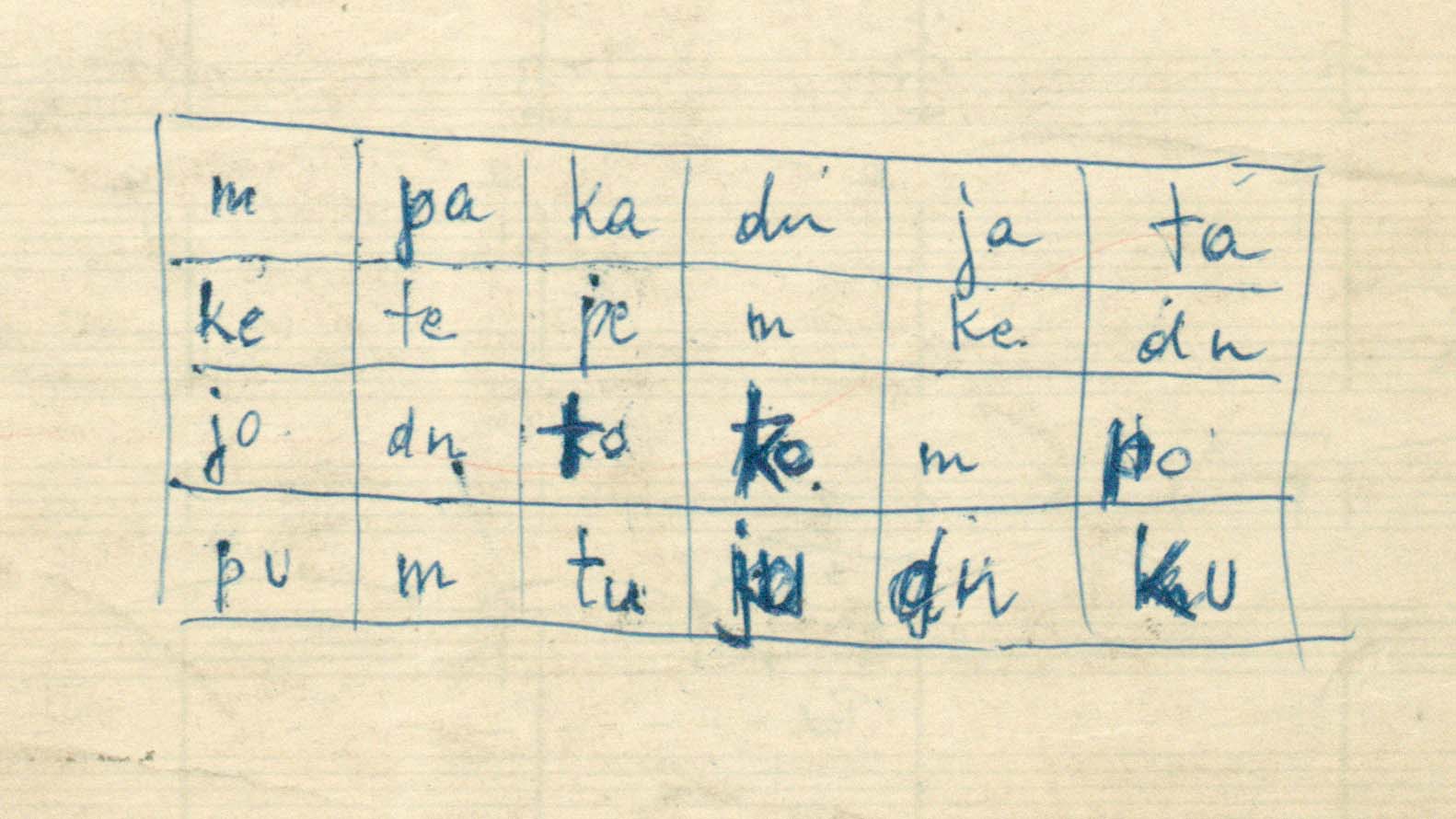
Cerha, Relationi fragili, handwritten score, set of syllables, AdZ, 00000049/92
Finally, the close affinity to the serialist style as heard in Intersecazioni borrows a compositional technique that is at the height of its claim to dominance. Instead of maintaining a uniform structure, it is integrated into a complex system that is committed to the cybernetic mentality. Within this system, it competes with other techniques and creative options. With Intersecazioni, Cerha created a kaleidoscope of interactions, possibilities, and potential for conflict—a thoroughly “adventurous” undertaking for its time.

